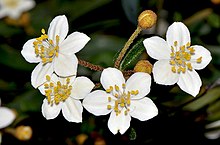Asterolasia pallida
Asterolasia pallida is a species of woody, perennial herb that is endemic to the southwest of Western Australia. It has elliptical leaves and white flowers arranged in umbels of three to six with star-shaped hairs on the back of the petals and fifteen to twenty-five stamens.
| Asterolasia pallida | |
|---|---|
 | |
| Scientific classification | |
| Kingdom: | Plantae |
| Clade: | Tracheophytes |
| Clade: | Angiosperms |
| Clade: | Eudicots |
| Clade: | Rosids |
| Order: | Sapindales |
| Family: | Rutaceae |
| Genus: | Asterolasia |
| Species: | A. pallida |
| Binomial name | |
| Asterolasia pallida | |
| Synonyms[1] | |
| |
Description
Asterolasia pallida is a woody, perennial herb that typically grows to a height of about 1 m (3 ft 3 in) and sometimes forms a rhizome. The leaves are elliptical, 10–25 mm (0.39–0.98 in) long and covered with star-shaped hairs on the lower side. The flowers are arranged in umbels of three to six in leaf axils and on the ends of branchlets, each flower on a thin pedicel 3–10 mm (0.12–0.39 in) long. The petals are white, elliptical, 4–8 mm (0.16–0.31 in) long, with rust-coloured and colourless, star-shaped hairs on the back, and there are fifteen to twenty-five stamens.[2][3]
Taxonomy
Asterolasia pallida was first formally described in 1863 by George Bentham and the description was published in Flora Australiensis from specimens collected by James Drummond.[4][5]
In 1998, Paul Wilson described two subspecies and the names are accepted by the Australian Plant Census:
- Asterolasia pallida subsp. hyalina has petals with only colourless hairs on the back of the petals and only occurs in the Dryandra State Forest south-east of Perth;[6]
- Asterolasia pallida subsp. pallida has both colourless and reddish hairs on the back of the petals and has a widespread distribution on the Darling Range.[7][8]
Distribution and habitat
This species grows on laterite in jarrah - marri woodland on the Darling Range from near Perth to Manjimup. Subspecies hyalina is restricted to the Dryandra State Forest.[8][2]
Conservation status
Asterolasia pallida is classified as "not threatened" by the Government of Western Australia Department of Parks and Wildlife.[3]
References
- "Asterolasia pallida". Australian Plant Census. Retrieved 28 June 2020.
- Wilson, Paul G. "Asterolasia pallida". Australian Biological Resources Study, Department of Agriculture, Water and the Environment, Canberra. Retrieved 28 June 2020.
- "Asterolasia pallida". FloraBase. Western Australian Government Department of Parks and Wildlife.
- "Asterolasia pallida". APNI. Retrieved 28 June 2020.
- Bentham, George; von Mueller, Ferdinand (1863). Flora Australiensis. London: Lovell Reeve & Co. p. 352. Retrieved 28 June 2020.
- "Asterolasia pallida subsp. hyalina". Australian Plant Census. Retrieved 28 June 2020.
- "Asterolasia pallida subsp. pallida". Australian Plant Census. Retrieved 28 June 2020.
- Wilson, Paul G. (1988). "Nomenclatural notes and new taxa in the genera Asterolasia, Drummondita and Microcybe (Rutaceae: Boronieae)". Nuytsia. 12 (1): 84–85. Retrieved 28 June 2020.